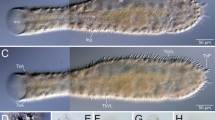Summary
The covering layer of Gyrocotyle, which is thought to occupy an intermediate position between the monogeneans and the cestodes, resembles that of the cestodes more than the epidermis of the ectoparasitic monogeneans. It is a cytoplasmic epidermis bearing densely arranged microvilli and is connected to parenchymally situated cell bodies. The microvilli of Gyrocotyle differ from the microtriches of tapeworms in lacking a thickened tip. Vesicles between the microvilli at the free edge of the epidermis are associated with disintegrating striated rod-bodies and are therefore probably secretory rather than concerned with micropinocytosis. The epidermal cell bodies have the characteristics of secretory cells and appear to elaborate the striated rod-bodies which occur throughout the outer epidermis and may consist of condensed mucoprotein. Cells with electron opaque cytoplasm which occur in the neighbourhood of the epidermal cell bodies have been identified as myoblasts. The posterior rosette appears to be specialized for adhesion as gland cells secreting PAS positive material line the ventral rosette surface and the epidermis of this region bears short bifurcate microvilli.
Zusammenfassung
Die Deckschicht von Gyrocotyle, die offenbar eine Zwischen-stellung zwischen der von Monogenen, Trematoden und Cestoden einnimmt, ist der von Cestoden mehr als der Epidermis ektoparasitischer Monogenea ähnlich. Sie stellt eine zytoplasmatische Epidermis dar, die aus dicht stehenden Mikrovilli besteht, und ist verbunden mit einem parenchymatösen Zellkörper. Die Mikrovilli von Gyrocotyle unterscheidet sich von den Mikrotrichen der Bandwürmer darin, daß ihnen eine verdickte Spitze fehlt. Bläschen zwischen der Mikrovilli am freien Rand der Epidermis hängt mit zerfallenden gestreiften stäbchenförmigen Körpern zusammen und sind eher sekretorischer Natur als Ausdruck einer Mikropinozytose. Die epidermalen Zellkörper haben die charakteristischen Eigenschaften von sekretorischen Zellen und scheinen die gestreiften länglichen Körper auszuscheiden, die über die ganze Epidermis verteilt vorkommen und aus einem kondensierten Mukoprotein bestehen. Zellen mit elektronendichtem Zytoplasma, die in der Nachbarschaft der epidermalen Zellkörper auftreten, sind als Myoblasten identifiziert worden. Die hintere Rosette erscheint spezialisiert zum Anheften wie Drüsenzellen; sie sezernieren PAS-positives Material entlang der ventralen Rosetten-Oberfläche. Die Epidermis dieser Region trägt kurze zweigallige Mikrovilli.
Similar content being viewed by others
References
Béguin, F.: Étude au microscope électronique de la cuticule et de ses structures associeés chez quelques cestodes. Éssai d'histologie comparée. Z. Zellforsch. 72, 30–46 (1966).
Bråten, T.: An electron microscope study of the tegument and associated structures of the proceroid of Diphyllobothrium latum. Z. Parasitenk. 30, 9–103 (1968a).
— The fine structure of the tegument of Diphyllobothrium latum (L). A comparison of the plerocercoid and adult stages. Z. Parasitenk. 30, 104–112 (1968b).
Bychowsky, B. E.: Monogenetic trematodes - their systematics and phylogeny, ed. W. J. Hargis Jr. Washington, D. C.: American institute of biological sciences 1957.
Charles, G. H., Orr, T. S. C.: Comparative fine structure of outer tegument of Ligula intestinalis and Schistocephalus solidus. Exp. Parasit. 22, 137–149 (1968).
Erasmus, D. A.: The host-parasite interface of Cyathocotyle bushiensis Khan, 1962 (Trematoda, Strigeoidea). II. Electron microscope studies of the tegument. J. Parasit. 53, 703–714 (1967).
Halvorsen, O., Williams, H. H.: Studies on the helminth fauna of Norway. IX. Gyrocotyle (Platyhelminthes) in Chimaera monstrosa from Oslo fjord, with emphasis on its mode of attachment and regulation in the degree of infection. Nytt Mag. Zool. 15, 130–142 (1968).
Ito, S.: The enteric surface coat on cat intestinal microvilli. J. Cell Biol. 27, 475–491 (1965).
Lee, D. L.: The structure and composition of the helminth cuticle. In: Advances in parasitology, vol. IV (B. Dawes, ed.). New York: Academic Press 1966.
Llewellyn, J.: The evolution of parasitic platyhelminths. In: Third symposium of the British Society for Parasitology. Oxford: Blackwell 1965.
Lumsden, R. D.: Cytological studies on the absorptive surfaces of cestodes. I. The fine structure of the strobilar integument. Z. Parasitenk. 27, 355–382 (1966).
— Cytological studies on the absorptive surfaces of cestodes. III Hydrolysis of phosphate esters. J. Parasit. 54, 524–535 (1968).
— Byram III, J.: The ultrastructure of cestode muscle. J. Parasit. 53, 326–342 (1967).
Lyons, K. M.: A comparison of the adult epidermis of some monegeneans: the development of the outer layer in Entobdella soleae. Parasitology 58 (Suppl.), 14 P (1968).
-- The fine structure of the adult epidermis of two skin parasitic monogeneans, Entobdella soleae and Acanthocotyle elegans. In preparation.
Morseth, D. J.: Fine structure of the hydatid cyst and protoscolex of Echinococcus granulosus. J. Parasit. 53, 312–325 (1967a).
— Observations on the fine structure of the nervous system of Echinococcus granulosus. J. Parasit. 53, 492–500 (1967b).
Pearse, A. G. E.: Histochemistry theoretical and applied, 2nd ed. London: J. & A. Churchill Ltd. 1961.
Rothman, A. H.: Colloid transport in the cestode Hymenolepis diminuta. Exp. Parasit. 21, 133–136 (1967).
Santos, de Souza: The ultrastructure of mucous granules from starfish J. Ultrastruct. Res. 16, 259–268 (1966). tube feet.
Taylor, E. W., Thomas, J. N.: Membrane (contact) digestion in three species of tapeworm, Hymenolepis diminuta, Hymenolepis microstoma and Moniezia expansa. Parasitology 58, 535–546 (1968).
Threadgold, L. T.: An electron microscope study of the tegument and associated structures of Proteocephalus pollanicoli. Parasitology 55, 467–472 (1965).
— The ultrastructure of the animal cell. Oxford: Pergamon Press 1967.
Watson, E. E.: The genus Gyrocotyle and its significance for problems of cestode structure and phylogeny. Univ. Calif. Publs. Zool. 6, 353–468 (1911).
Williams, H. H.: Phyllobothrium piriei sp. nov. (Cestoda: Tetraphyllidea) from Raja naevus with a comment on its habitat and mode of attachment. Parasitology 58, 929–937 (1968).
Wilson, T. H.: In: The cellular functions of membrane transport (J. F. Hoffman ed.) New Jersey: Prentice-Hall 1963.
Author information
Authors and Affiliations
Rights and permissions
About this article
Cite this article
Lyons, K.M. The fine structure of the body wall of Gyrocotyle urna . Z. F. Parasitenkunde 33, 95–109 (1969). https://doi.org/10.1007/BF00259511
Received:
Issue Date:
DOI: https://doi.org/10.1007/BF00259511




